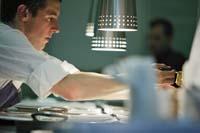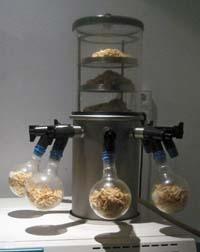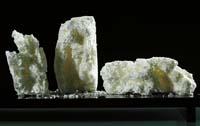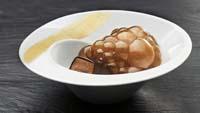Technology on the plate

Saying that cooking is art or science is not easy in today's leading restaurants. It has a lot of both and we wanted to go to two restaurants in the area to talk about the part that touches us. We have been at the Mugaritz restaurant, with Dani Lasa, head of the restaurant's R&D department. And we have also been in Arzak, with investigative chefs Igor Zalakain, Xabier Gutierrez and Mikel Sorazu, who work in their laboratory.
In his work we have come to know the role that technology plays. Everyone is very clear: technology is very important and has always had it. "To the extent that it serves us to do different and better things, we will always take the technology with good taste," says Gutiérrez. Technology helps chefs a lot. It offers great accuracy, facilitates many steps that were previously much more complex and you can get things that were previously impossible with today's machines. That's why "thanks to technology we can continue to evolve," said Zalakain.
However, care must be taken with technology. According to Lasa, "technology can do very well to a good cook, but a bad cook can also do very bad". And it is not convenient to use technology without optimal measures or criteria. "In recent years, there has sometimes been a tendency to overprotect themselves in technology and in the end the gastronomic perspective is lost." "Technology is not panacea," says Gutierrez, "it's just an aid." And in some dishes it is more important than in others. For example, "if you want to get a special texture in an egg, it is essential to have a thermostat that precisely controls the temperature," says Zalakain.
A thermostat called Roner is used for this purpose. Roner has become a fundamental tool in many restaurants. It allows to control a bath of Mary with a precision of a tenth degree. In Mugaritz, for example, it is mainly used for long cooking. Temperature becomes very important in these cooking. It is necessary to take into account when the collagen is denatured or when myoglobin is damaged to get a meat to the best point. Lasa has given us an example of chicken: "thighs are made at 72 degrees and breast at 54 degrees."

In vacuum
Normally the products are empty before entering the Roner. "Vacuum cooking has been a big step," says Lasa. This technique respects much more the structure of the product and does not present losses of liquids or flavor. In Mugaritz the meats are prepared: At a temperature of about 65 degrees, they keep it a day and a half. The result is a completely pink meat, but with fully softened fibers and collagen turned into gelatin.
Working in vacuum reduces temperatures. For example, the machine called Rotaval consists of vacuum distillations at low temperatures. In conventional distillations, alcohols are distilled at 68-70ºC, while water-based distillations require more than 100ºC. In the vacuum, however, the water boils at 20º, allowing to distill with the Rotaval aqueous solutions at 16-20ºC and alcohol at 9-10ºC.
"At these temperatures you can get many vapors that were previously lost," explains Lasa- and the extremely bitter essences can be achieved without bitterness. In addition, what remains in the initial solution is very interesting. When removing the water remains a concentrate. Previously the concentrates were obtained with fire, but these facts at a much lower temperature are different."

Another interesting use of gastrovac is to give a new taste to a product. Lasa sets an example of a peach dish they made last year. The peach bone contains almond aromas (very bitter taste). Therefore, they prepared a syrup with almond essence, placed it in the Gastrovac and there they put the peach peeled. The gastrovac removes all the air, even the peach in part, and then, as the air enters, it takes its place; but since the peach is stuck in the syrup, the syrup gets into place of the air. After several steps of this type, "we got a raw peach, as if it were preserved, but harder, with an almond flavor that remembered its bone".
From vacuum to cold
At Arzak they also work a lot in the vacuum. Freeze-drying, for example, gives them many possibilities. Freeze-drying is a vacuum dehydration at very low temperature. Thus, product characteristics are stored much better than in normal drying. In normal drying the product loses water, but also mineral salts, proteins, color, etc. In freeze-drying they remain. Lyophilisates are used in Arzak to enhance flavors, freeze-drying and breaking chicken, egg yolk, etc.

In addition, "we've done a lot of fun things with freeze-drying," says Gutierrez. "Hot cheese ice cream," continues Zalakain. Cheese ice cream is placed in the lyophilizer at -50.5°C and 0.065 mBar. In these conditions, the ice cream triples its volume and dries. "The dish that comes to the table is very tasty, tastes like cheese ice cream, but it is dry, crisp and at room temperature," says Zalakain.
On the other hand, Arzak has highlighted the use of gases. They work with three gases: nitrogen, carbon dioxide and tetrafluorethane. These gases produce mainly cold, nitrogen -196 °C and the rest -81 and -86 °C. "Hearing nitrogen, CO 2, etc. people worry," says Gutierrez, "but it's just a way to freeze nitrogen. Freeze very fast and respect the product much more. That serves us to play with ice cream, without completely freezing things." For example, "from the outside we can get something hard but in a fluid state," says Zalakain.
And with CO 2 the same thing happens, "when we drink a beer or champagne we are taking CO 2" Gutierrez. "We use CO 2 to make bubbles with dairy products, helping some braised fruits. And with tetrafluorethane we make images of chocolate, which can be made in a few seconds before the customer if you want."
New applications

However, outside the coffee maker, many of the technologies they use come directly from scientific laboratories or industry. Everyone recognizes that the machinery for a kitchen is quite expensive, but "if we know how to manage it well, they apply it to the letter and, above all, they make sense, they are worth it," says Lasa.
"When the cooks have a new machine or technique in hand," said Mugaritz, "we can be tempted to do everything with it. We, for example, might be tempted to include 4 distillates in a 12-14 course menu. But if you want to surprise yourself, it has to be once, doing it more times loses value, the same formula can not be repeated many times. We use distiller, but very measured. And we continue to investigate the possibilities it offers, and in that sense we do many things, but when it comes to going to the table we have to measure a lot."
Collaborating with scientists

To continue bringing new dishes to the table and new sensations have to continue researching. And in this research the support of scientists and technologists is very useful. For example, Arzak's friends have at their disposal the Tecnun School of Engineers and the Faculty of Chemistry of San Sebastian. In fact, through a friend of the Faculty of Chemistry, freeze-drying was known, for example.
And not only with scientists, "we are interested in having conversations with carpenters, architects or painters, because then we can apply their techniques or ideas in the kitchen". On the other hand, "we cannot know everything, and it is imperative that scientists who inform and support us are close."
Mugaritz's are clearly committed to approaching science and technology. In the restaurant itself there is a chemist who investigates the possibilities offered by hydrocolloids, among others. And in recent years they collaborate with the Azti technology center. Lasa is very clear: "The chefs have always acted empirically. We, when we wanted to get something, did tests and did things, but without knowing very well why things happened, we wasted a lot of time. We realized that there had to be some other way to do this differently and that it could be to approach scientists."
Many projects are now being developed in collaboration with Azti. Sometimes these are orders placed by a third company. For example, at the request of a Galician company, they have worked with monkfish liver. "It is currently abandoned, but it is a very rich product. We have analyzed the commercial possibilities of this product: in a terrine, in my quit, smoked...", says Lasa.

They have gotten edible bubbles with enough tension to stay on the plate. But these bubbles have been achieved when they were looking for something else. They remembered the bells that served food in French cuisine. These bells have a very specific function: they keep the heat and vapors inside, and when removing the bell these vapors reach the customer. "We started thinking if we could make an edible bell, a big bubble to release the vapors from the inside when it broke with the fork. And so we got to the bubbles."
"Our biggest challenge is to see that today there is nothing nearly impossible," says Lasa, "but as we get new opportunities, we have to put limits. Do not forget that people come to eat. However, our goal is not to feed the stomachs, but to feed the souls. We don’t want to be just cooks, we have other concerns and we try to express it, as we know.”
On many occasions, cooks who go in this line also receive rigorous reviews. "People are never prepared to accept too innovative things," says Gutierrez. "People are scared, but they have never eaten as safe as now, never! ".

According to Lasa, "with the latest polemics there has been a great setback." "Now we have to begin to clarify many things that society considered overcome. But, really, should we start saying that salt is an additive, also sugar, that parsley is toxic from a certain amount? Do not forget that my partner is now at the Ordizia fair, choosing the best products in the area. Then, in our way, we will try to prepare it in the best possible way. All the technology is to place these products on an altar."





